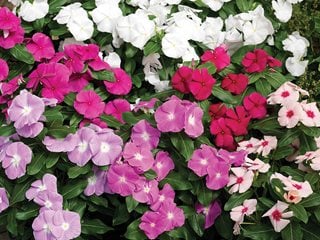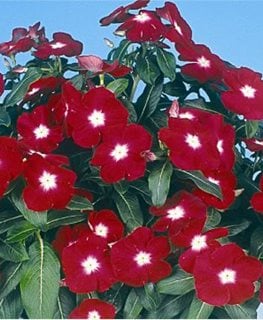Our Favorite Vinca Flowers for Vibrant Color
These sun-loving, heat-tolerant annuals come in more colors and varieties than ever before. Here are some of our top picks.If you love the look of impatiens but need a carefree flowering annual that thrives in full sun, annual vinca is a great choice. Both plants produce an abundance of small, colorful flowers all summer long. But while most impatiens wither in hot, dry weather, vinca is undaunted by intense summer heat, making it a favorite choice for southern gardens.
And talk about variety! In addition to the usual pastel tones, you can now find yummy shades like grape, blackberry, apricot, cherry red, and tangerine—often enhanced by contrasting eyes. A wide range of growth habits are available, including trailing and dwarf forms tailor-made for containers and hanging baskets.
On this page: Basics | Growing Tips | Caring for Vinca | Annual Vinca Pictures
VINCA BASICS
Botanical name:
Catharanthus roseus
Common names:
Madagascar periwinkle
Zones:
Technically a tender perennial in Zones 9 to 11, but usually grown as an annual in most climates.
Height/spread:
Typically 12 to 24 inches tall and wide, with the exception of dwarf and trailing types.
Bloom time:
Early summer until frost.
Special features:
- Attracts butterflies.
- Heat and drought tolerant.
- Needs no deadheading.
- Attractive glossy green leaves.
- Rabbit resistant.
- Pest and disease resistant.
Note: Not to be confused with common periwinkle (Vinca minor) and greater periwinkle (Vinca major), which are low-growing, evergreen perennials often used as groundcovers.
GROWING TIPS
Where to plant:
In full sun to part shade in well-drained soil.
When to plant:
After the ground has warmed up in the spring, typically mid-May or later in northern climates.
Growing from seed:
Sow seeds indoors 10 to 12 weeks prior to the last frost date in your area, following the instructions on the seed packet. Seeds germinate best when the soil temperatures are over 75° F. Transplant seedlings outdoors once air and soil temperatures are consistently above 65° F.
Growing in containers:
Plant in any general-purpose, well-draining potting soil. One with a slow-release fertilizer will keep your plants well fed for a month or longer and get them off to a vigorous start. If combining vincas in the same container with other annuals or perennials, choose varieties that have the same exposure and water requirements.
Planting in the garden:
Space plants far enough apart to ensure good air circulation (about 8 to 12 inches, depending on plant size at maturity). In heavy soils, work in some compost at planting time to improve aeration.
CARING FOR VINCA
Watering:
Vincas like their soil to be on the dry side, so only water when the top inch or so of the soil feels dry to the touch or when rainfall is insufficient to supply an inch of water per week. To prevent leaf spot and fungal diseases, avoid overhead watering or water your plants early in the morning so the foliage has plenty of time to dry before nightfall.
Fertilizing:
Apply a light top dressing of compost or a slow-release granular fertilizer at planting time. Container-grown plants may need more frequent feedings with a liquid fertilizer.
Pruning:
Although pruning is unnecessary, you can pinch plants back if you want a fuller appearance. Flowers are self-cleaning, sparing you the chore of deadheading.
Pests and problems:
Annual vinca is invincible to most pests, but it can succumb to stem and root rot caused by Phytophthora—a soil- and water-borne fungal-like microorganism. The best preventive measures are to avoid overwatering and provide good drainage. These plants are also susceptible to leaf spot diseases, with the best defense being good air circulation and to water them in the morning. Another way to avoid fungal problems is to plant one of the newer disease-resistant cultivars, such as the Cora® series.
ANNUAL VINCA PICTURES
RELATED:
Amazing Annual Flowers for Sun
Impatiens Flowers for Sun or Shade











